The Collapse in Relation to GDP
In an earlier post, I discussed the startling decline in US imports [0]. Brad Setser has also reported on this phenomenon. This decline is not restricted to the United States, as noted in an OECD report released last week (h/t Torsten Slok):
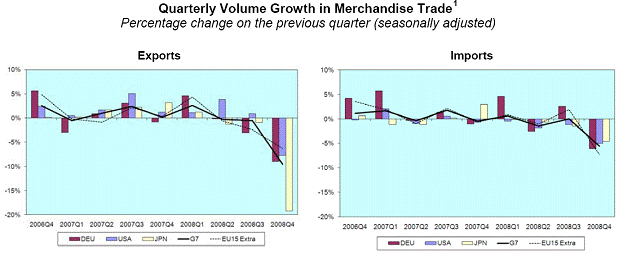
Figure 1: From OECD, “Trade flows collapse in Q4 2008 but signs of falls easing in early 2009,” March 30, 2009. Data available here.
One salient question would be what this decline (in the US) presages for near term imports and exports, and hence output growth going forward. First, I think it’s important to go beyond the impact of the trade balance. If one examined the contribution (in an accounting sense) of the external components to overall GDP growth, one would think that there wasn’t much action here.
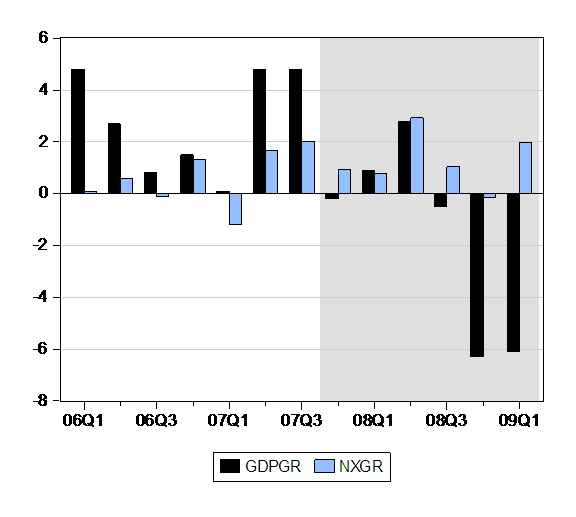
Figure 2: Annualized q/q growth of GDP (black bars) and contribution of net exports (blue bars), both in percentage points. NBER recession dates shaded gray. Source: BEA, GDP advance release of 26 April 2009, and NBER. [Graph corrected 9:30am 5/5]
Clearly net exports contributed in a mechanical sense accounted for a lot of GDP growth, particularly in 2008Q3 2008Q2, while there seems little relevance for the 2009Q1 number. However, this overall net exports figure masks wildly divergent trends, highlighted in Figure 3.
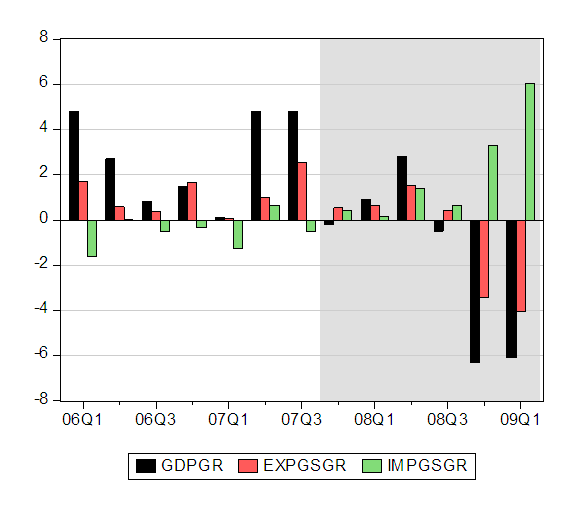
Figure 3: Annualized q/q growth of GDP (black bars) and contribution of exports (red bars), and imports (green bars), all in percentage points. NBER recession dates shaded gray. Source: BEA, GDP advance release of 26 April 2009, and NBER. [Graph corrected 9:30am 5/5]
How Common Are Big Import and Export Comovements
The graph highlights the fact that the large negative contribution of the export collapse is roughly equal to the large positive contribution of the import collapse. At a recent conference, I was asked whether this was a common occurrence. My guess was that it wasn’t, but I thought I’d check. So here is a look at what (non-agricultural goods) exports and (non-oil goods) imports do over the longer haul.
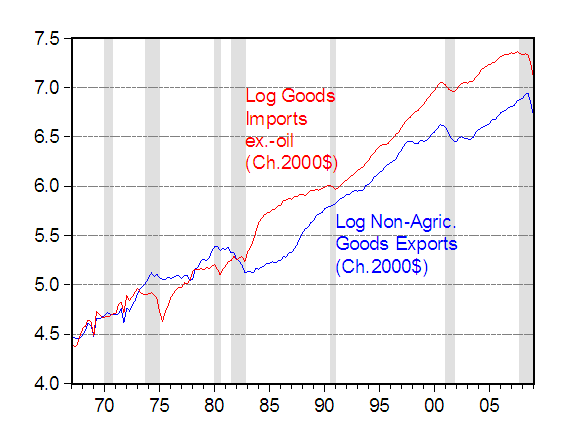
Figure 4: Log non-agricultural goods exports (blue) and log goods imports ex-oil (red), in Ch.2000$ SAAR. NBER recession dates shaded gray. Source: BEA, GDP advance release of 26 April 2009, and NBER.
Casual inspection of Figure 4 seems to suggest large comovement of imports and exports is not commonplace (this is somewhat different from the finding that HP-filtered imports and exports are procyclical, which pertains to “normal” fluctuations). Figure 5 provides a detail on the current and last recession, in growth rates.
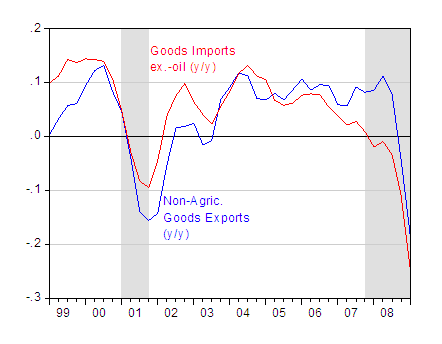
Figure 5: Year-on-year growth rates of non-agricultural goods exports (blue) and of goods imports ex-oil (red), calculated as four quarter log differences. NBER recession dates shaded gray. Source: BEA, GDP advance release of 26 April 2009, NBER, and author’s calculations.
I have two observations at this juncture.
- Comovements seem particularly pronounced in the previous and current recession.
- The current downturn is particularly sharp.
This latter point is illustrated by Figure 6, wherein I’ve showed the largest, correlated changes (negative changes in southwest quadrant; positive changes in northwest quadrant). What is interesting is that the previous large (q/q) changes were short-lived, and essentially reversed. The 2008Q4 and 2009Q1 are the only very large back-to-back changes I can find. (Unless the BEA’s guesses of what March imports and exports are really way off, then this is a remarkable outcome).
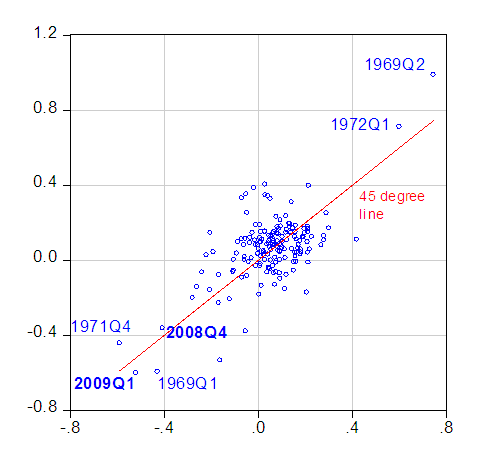
Figure 6: Quarter-on-quarter annualized growth rates of goods imports ex-oil (vertical axis) against non-agricultural goods exports (horizontal axis), calculated as log differences. Source: BEA, GDP advance release of 26 April 2009, NBER, and author’s calculations.
Causes
So, we come to the question of what is causing this correlated and deep decrease in trade flows. A recent VoxEU post documented the decline in US and European trade flows, arguing that this decline is more likely associated with depressed economic activity and diminished access to credit, rather than to trade protectionism. I agree that thus far, this characterization seems correct. So, this leads to the other possibilities.
- Is it trade financing?
- Is it inventory decumulation?
- Is it vertical specialization?
(By the way, I don’t have a definitive answer; and these explanations are not mutually exclusive)
I think the downturn is in large part due to the lack of trade financing. But box 1.2 in the most recent OECD Economic Outlook Interim Report notes that it is difficult to explain the decline in trade growth using proxy measures for credit problems.
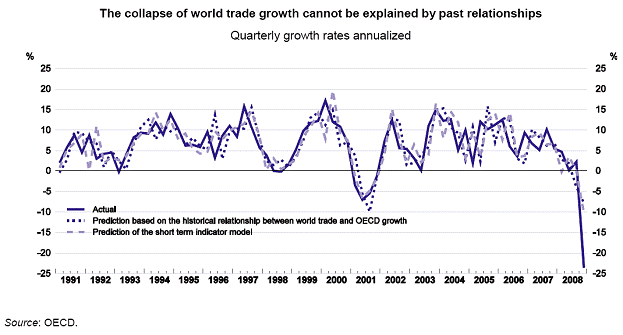
Figure 7: from OECD Economic Outlook Interim Report, Box 1.2. Two models are used to explain world trade. The first model is an indicator-based model that relates world trade to industrial production in the OECD countries and Brazil, China, India, Indonesia and the Russian Federation; export orders in the G7 countries (except Canada); the US tech pulse index; world semiconductor billings; and US credit standards. Monthly VAR models are used to forecast these variables over the very short term. The second model is based on the historical relationship between world trade growth, OECD GDP growth and US credit standards.
The study used the US loan officer survey data as a proxy measure for credit availability; my guess is that this is a poor proxy, and that we can’t rule out credit factors as an explanatory variable.
Is it inventory decumulation? Reader spencer suggests modeling imports as a function of lagged GDP, relative prices, and inventory changes (see comments to this post), I believe motivated by the view that big import changes are associated with inventory investment/disinvestment in this era of just-in-time supply management. Figure 8 suggests that there is a high correlation, especially in the post 1998 period. But the last two observations seem quite out of line with the previous observations, even post 1998. This suggests that inventory decumulation is not the only factor at work. It also suggests that a bounceback in imports is not in the cards, even if inventory accumulation resumes.
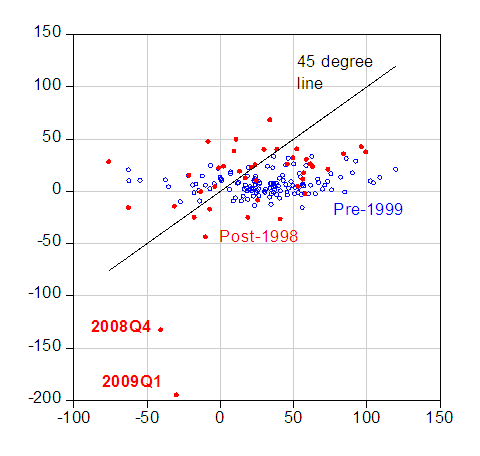
Figure 8: Quarterly change in goods imports ex-oil (vertical axis) against lagged inventory investment deflated by the GDP deflator (horizontal axis), in Ch.2000$. Blue circles, pre-1999; red circles, post-1998. Source: BEA, GDP advance release of 26 April 2009, and author’s calculations.
Vertical specialization? As I have discussed in several previous posts [1] [2], much trade is now characterized by vertical specialization, where inputs are imported for incorporation in production in imports of exports. The decline in imports could then be driven by the decline in US exports, although it is hard to assess this channel since we do not have a good grasp of the extent of vertical specialization [3] .
Summing up, it seems to me that all three factors are likely in play. For me, though, the inventory channel does not seem to be important enough to imply a big bounceback in imports.
Outsource living to India and crazy Americans die or get expelled to some other planet.
“So, we come to the question of what is causing this correlated and deep decrease in trade flows.”
Is it TOO MUCH CONSUMER DEBT on the lower and middle class in the high wage countries because they are trying to make up for negative real earnings growth due to a globally oversupplied labor market?
Is the money supply mix out of whack too?
Did something similar happen right before or during the Great Depression?
Are central bankers to blame for too much debt?
Other Brad Setser articles:
http://blogs.cfr.org/setser/2009/03/23/financial-de-globalization-illustrated/
http://blogs.cfr.org/setser/2009/04/06/charting-financial-de-globalization-private-capital-flows-are-falling-faster-trade-flows/
Menzie,
Excellent post!
I agree with you that the change in imports/exports is not due to protectionism. Consider that the monetary expansion that facilitated the dot com bubble and then the housing bubble probably also contributed to a more general consumption bubble fueling imports from suppliers especially the BRIC countries and central Europe. When the bubbles burst US consumption crashed and imports crashed. Just an eyeball look at your graphs tends to show that imports increase in good times and decrease in bad.
The Treasury, FED and especially congress contributed to the decline when they attacked China for monetary manipulation leading to a decline of confidence in the dollar.
Seeing the decline the big three attempted to use moneytary injections to prop up consumption and prices but when interest rates went to zero the FED had to actually create a situation where they manufactured negative interst rates to keep pumping in money. The result, as has been shown many times on this forum, is that banks have actually pulled money out of circulation to take advantage of the risk free money the FED is giving by paying interest on reserves.
I appreciate your observation, “The decline in imports could then be driven by the decline in US exports…”, but the opposite could also be true. The decline in exports could be driven by the decline in imports as countries have fewer dollars to use for our exports. This seems to be especially true with China’s huge fall in trade wtih the US.
I watch trains, to evidence the vitality of the export/import trade with Canada. Lately, I’ve noticed trains are tending to be full, though shorter heading north and often empty heading south. Reasons by priority of impact:
1) American consumer demand (low to middle class) is a freefall, no relief for 48 to 60 mos.
2) Credit is tight, even for the imort/export folks
3) Inventories are being burned off due to lack of demand and ability to get credit for restock.
I also watch the shelves at the local stores. The inventory level in some stores has reached the point where there are empty spots between products and in some cases, for the first time in my life, age 52, product is not in stock.
Real world thus suggests America’s chickens have in fact come to roost. The good news is we are now saving at an astounding rate!!
Agreed. I think you also listed the 3 factors in order of decreasing importance… just as Libor spreads are elevated because banks do not trust each other, trade finance such as letters of credit are more expensive.
Minor typos, in description of figure 8, “blue circles” instead of “red circles”
Also, in the second to last paragraph “incorporation in production in imports.”, don’t you mean exports?
Since the Asian mercantilists refuse to trade, wanting only to export and refusing to import, and to enforce that state manipulate their exchange rates such that goods from other nations cannot be exported to them at competitive prices, consumers in other nations can buy the Asian exports only if they themselves, or their governments on their behalf, are willing to go evermore into debt to the Asians.
As credit-worthy Western consumers have more debt than they want, and the mechanisms of the housing bubble for lending to un-credit-worthy consumers have ceased to function, the only entities left to do the borrowing are Western governments. Clearly, those governments have not stepped up to the plate. Unless they do, it’s over.
We are not going to return to the status quo ante in which Western consumers’ debt loads rose every year, seemingly without limit.
There was a limit. Western consumers not only reached but went over it, and are now deleveraging back down to it.
MikeR: Thanks for catching the typos; I’ve corrected those mistakes.
Pardon me for being spectacularly simple-minded, but aren’t we in a world-wide recession and people and businesses everywhere are just buying less stuff (oops, I meant to say aggregate demand has declined)? It does not seem surprising that both imports and exports are down.
Q1 09 positive contribution of 6.05% to GDP and negative contribuition of 4.06% for exports. Net exports had a positive contribution of 1.99% to Q1 09 GDP. Your graph shows and negative contribution for net exports….I beleive that is incorrect…it should be 1.99%
Hondo: Thanks, you’re right. Figures 2 and 3 are corrected.
Awkward title.
Agree with jm. However, China’s surplus is still growing and Asian currencies are still undervalued (including the yen). The Fed’s actions are pushing more of the Asian trade surpluses in Europe’s direction. I think this is short-sighted policy and will lead to protectionist pressures there.
Note that exports shrank more than imports after the dotcom bust, whereas this time around, imports shrank more than exports. After the dotcom bust, much of the aggregate demand created by expansionary U.S. fiscal and monetary policies went to support aggregate demand abroad, with a huge build-up in reserves in Asia, augmented by the yen carry trade. These things certainly contributed to current imbalances, and the imbalances are still growing (the U.S. is still running a very large trade deficit at 3% of GDP).
A key contributor to the non-linear drop in trade is the partial failure of the letters of credit/trade financing marketplace. In financial blogs, there have been many pointed comments about companies inability to get normal financial support for trade transactions. I don’t know where one gets high level statistics for this area.
The key point here is US on balance “exporting” recession, shown by the blue bars in the plus in first chart. Our net positive GDP contribution is the rest of world negative GDP contribution.
Its brutal out there for rest of world. Not only is the US locomotive massively in reverse, but places like emerging asia and europe deeply relied on goods exports. WE have Eximbank and ag export finance. They had private sector trade finance, a complex business with letters of credit, shipments as collateral etc. That has collapsed, and even new IMF and other BOP support may not bring back.
For shifts this large, exports and imports have to be correlated to some extent, just to keep the trade deficit in line with the the structure of US production, demand and savings. Don’t ask me how this adjustment gets forced onto the world.
As to the causes of US import decline, I see it mainly in US final demand. Q1 2008 to Q1 2009, two-thirds of the decline is in capital goods (down about 20%) and in automotive (down around 45%). Decline over same period in investment in equipment and software, 20%. Decline in light vehicle sales, 37%.
Probably account for a little in inventory shrinkage. Who knows about vertical integration to exports? Extremely skeptical of the trade finance story.
My first inclination was to go with Joseph – its just nobody’s buying. The data disagree.
Imports as a share of personal consumption expenditures declines by 6 percentage points between third quarter 2008 and first quarter 2009 (from 25% to 19%).
When we compare goods imports to goods consumed by personal sector it is even worse. 16 point decline in goods imports as a share of personal consumption of goods. Goes from 55% (I checked these numbers twice) to 40%.
I realize that maybe a third of imports go to production rather than consumption, nevertheless, imports are suffering.
I think fear and panic has a lot to do with this. Imports have a long lead time. US companies that import goods did not want to be caught with a lot of goods in transit while the economy was still in freefall.
There must be a silver lining in every cloud. I hope that problem will remain unsolved long enough to jumpstart production in the U.S. Maybe being able to get some goods in a hurry, if need be, will become more important than costs and the trade deficit will remain low.
My personal biais is for the U.S. government to reject free trade and use its power to reduce imports to a level near exports – PERMANENTLY.
Perhaps lending credence to the argument that there is a shortage of trade credits, I have noticed that for some time the DOW futures market has been below the spot, and by significant margins (20-40 points). Arbitrage flows should reverse this gap.
For some time neocons have been, under the guise of so called free trade which is really one way trade with jobs only going the other way, taking $50K chunks out of world economic demand and replacing them with $0 – thereby shrinking the basis for global economic demand and the global economic pie by $50K increments. We have been unemploying the champion consumers of all time , N. American middle class workers making roughly $50K/yr, and replacing them with 1.5 Asian subsistence slave wage workers hardly capable of feeding and clothing themselves never mind contributing to global economic demand – $0 addition to world economic demand.
How can anyone expect N. American economic recovery when the neocons have gotten us to think that exporting all of our manufacturing jobs is a good thing? It also sucks for China because they are destroying the consumers responsible for their economic growth – they are busy killing the goose that has laid the golden egg.
How, under this neocon trade regime, can either N. America or Asia ever recover economically? Even if we develop new ‘green’ products and technology, under current conditions the manufacturing jobs will go to Asia and the subsistence workers and N. American workers will continue to be unemployed!
Related to Ray’s point, given that trade is collapsing at such a level, does it become more sensible now to put up some barriers to encourage level standards of trade and keep the manufacturing sector from completely slipping out of sight in the U.S.?
The damage from any kind of trade war would be extremely small compared to a few years ago, and the groundwork could be laid to keep trade imbalances from springing up once (if?) the economy picks up again. The higher standards and wages can combine with dollar depreciation to keep export-driven businesses afloat for a time when they will be needed in recovery.
A lot of these trade problems are due to lack of demand world-wide, so wouldn’t maintaining higher wages (albeit artificially) more than offset the cosmetic gains from lower prices (the alleged “gains from trade”)? And couldn’t the raised demand from maintaining wages spark the need for more production in industries that are sorely lacking in the U.S. right now?
Speaking of inventory, I went to the outdoor shop last week and they were completely out of 9mm ammo of any and all types.
DickF wrote:
I agree with you that the change in imports/exports is not due to protectionism.
Menzie,
I would like to qualify this statement a little. Prior to Nixon pulling us off of the gold standard it was much more difficult to manipulate currencies. Protectionism was almost totally engaged through tariff policy and so was easy to detect.
Nixon pulled us off of the gold standard primarily to allow the US to engage in monetary battles against Japan under the theory that by manipulating the value of the dollar we could counter their economic gains.
Today China has taken the place of Japan in out monetary attacks, but the US monetary authorities also engage others in monetary battles. This has created a condition that greatly hinders international trade. This is especially true in a country appreciating its currency.
That said, US currency manipulation has been used to attack China, then congress threatens trade war against the Chinese for pegging their currency to the dollar. This is in fact protectionism. The rhetoric has slowed recently – even though one of Geithner’s first announcements attacked the Chinese monetary authorities as has Sec. of State Clinton – so I believe that international protectionism has slowed. But do not be deceived. Protectionism no longer resides in tariffs but in currency maniputlation.
“Murky Protectionism” is the use of subsidies of all kinds (in the U.S., France and other nations), tax policy (Germany and most other European countries) and well trained customs agents who can delay imports indefinitely, to reduce imports into a country. Everybody should know that Murky Protectionism is widespread. However, less imports will go to poor countries, regardless of the degree and kind of protectionism.
I would like to see all nations agree on this matter. Rather than trying to root out protectionism, which is impossible, we should all just agree that our goal, for every nation, is equal trade and that EACH NATIION SHOULD ADOPT EXPLICITY POLICIES WHICH LEAD THAT NATION TOWARD EQUAL TRADE.
There is no reason why a trade deficit country should be ashamed to adopt actions which move the imports toward a balance with exports sold. I want the U.S. to be explicit, up front with import restrictions. If every nation adopted the same kind of import restrictions, all the nations of the world would benefit, not just the U.S.
“protectionism” is a scare word, to stop people from thinking.
I am torn between being ashamed that I keep harping on this same theme, which is really tangential to the topic of the day and proud that I am one of the people who can see clearly where the U.S. has gone wrong and what should be done about it.
ReformerRay, You have a point about protectionism – the bulk of today’s currency intervention is just comptetitive devaluation by another name. However, our own Fed has entered this game as well now, so it is hard to throw stones with the proper righteous indignation. I also part company with you when you ask for balanced trade. I can see no legitimate grounds for disallowing all net international lending.
We have mechanisms to deal with protectionist measures other than currency interventions, but the latter are the elephants crowding the room. The cry should be against unnecessary reserve accumulations.
Don assumes, along with most international trade economists, that net international lending causes the trade deficit. Wrong. This is a case of reverse causation.
The trade deficit is independent of net interantional lending. The trade deficit is created by buying and selling of goods and services. That will happen because people seek bargins and profits. Market forces, disorted as they are by murky protectionism, are what cause the trade deficit.
A trade deficit requires that the U.S. send money overseas to pay for the trade deficit. That money is balanced by a net gain of goods and services sent to the U.S.
The owner of the dollars sent overseas to pay for our trade deficit can send it back to the U.S. or he can hold it for a while. Most opt to send it back. The prefer a U.S. asset to dollars. The return flow, in exchange for the money sent back, is some U.S. asset – a Treasury bond, mutual fund, ownership of a company, ownership of a farm, etc.
This money flow is only part of the currency flow that makes up international lending. But that part of international lending that is connected to the trade deficit is created by the size of the trade deficit and not the other way around.
I know Bernanke assumed otherwise in this famous speech about the Saving Glut but he was wrong then and he is wrong about many other things today – such as arguing that the U.S. financial system would be endangered today if mega banks failed.
I now see that I used incorrect terminology above. What I call “net international lending” is really total international lending. When swaps are netted out, and we have net international lending in the sense used by Don, what remins is the net gain in financial assets possessed by the nation that has a surplus of exports over imports.
Causation goes from the trade deficit to net international lending in the above sense. Since net international lending is produced by the trade deficit my sentence must be “Net international lending is controlled by the trade deficit”.
RR:
Regardless of the direction of causation, the balance of payments identity demands that the current account be the negative of the balance on capital flows (official plus private flows). No matter which way causation flows, to insist on current account balance is to insist on a net balance of zero for capital flows. Or in other words, net international lending is disallowed. (Note that I have shifted grounds on you slightly – the current account balance includes the balance on income flows, as well as on trade. I assume you would allow an imbalance in trade to make international income payments on already-existing international loans.)
As Menzie has pointed out before, ‘currency manipulation’ is a bit vague and hard to pin down exactly. That, as I see it, would be the main advantage of a simple balanced-trade constraint. But it seems clear that China’s massive reserve accumulations would qualify, regardless of the official U.S. Treasury position.
I agree with our last point. I, too, seriously question the need for the bailouts.
Most likely credit-driven. The nature of layoffs in late ’08 suggested balance sheet trauma. For example, I happened to sit in on a Schlumberger lecture at Princeton in October. The implicit purpose of the lecture was recruitment–Schlumberger had experienced difficulty in recruiting as many people as it needed. Then, almost without warning, Schlumberger laid of 6,000 people in December. That kind of turn around is very unusual. More indicative of financial trauma than lack of demand.
I agree with don when he says that the current account must be the negative of the capital flows. Except that those capital flows are not all the financial flows that occur between nations.
A trade balance would tend to move net international lending towards zero – except that the assets owned abroad would still continue to send revenue back to the owning nation. This amount was significant in the case of Japan in the period around the year 2000. As the years pass, the accumulation of assets by the Chinese government will also become important.
So, I return to the issue. If we agree that causation flows from the trade deficit to the trade balance and from there to the income balance and that that combination produces the current account balance and that the current account balance determines the size of the return flow (formerly the Capital Account, now labeled Financial Flow, which also is net international gain or loss of financial assets), why not agree that this subject should be approached from the perspective of the causes of the phenomenon?
I do not like a situation where the net financial assets are flowing from the U.S. to other countries. I prefer trade which does not require assets in the U.S. to have ownership transferred to a citizen, a firm or a government outside the U.S.
Most flow of funds betweeen nations are classified as swaps in that money that leaves one country is balanced by another financial asset flowing in the other direction, such as ownership of a company, some land, a private debt instrument or a Treasury certificate. That flow is not controlled by the trade deficit. And it would continue if the whole world would embrace my goal of equal trade. Equal trade will not hinder investment overseas.
Thanks, Steve Kopits, for the phrase “financial trama”. Trama is a good descriptive term for what happened.
I have no knowledge of decision makeing inside firms. But to an outsider, it looked like everybody decided that they were not going to be the foolish ones who did not adjust rapidly to the new reality. Anticipatory decisions seem to predominate. If that is the case, some hope going forward.
The big disappointment, for me, is the tendency for U.S. leadership (Bernanke and Geithner)to follow the Japanese example rather than the German one.
I don’t like to see the costs of our foolishness transferred to the future.
I agree with Menzie Chinn’s hunch that a lack of financing is causing the correlated and deep decreases in trade flows observed. Much of the recent growth in export markets and consumer demand has been driven by easy consumer credit (especially in the US and EU). Mere months ago, here in the US, you could purchase a German VW with no money down and Italian sunglasses with a credit card that charged an interest rate of less than 7%. Those days are gone. And with consumer demand down across the board, it would seem implausible that imports and exports wouldn’t be affected accordingly. I suspect that diminished financing is driving reductions in trade flows.